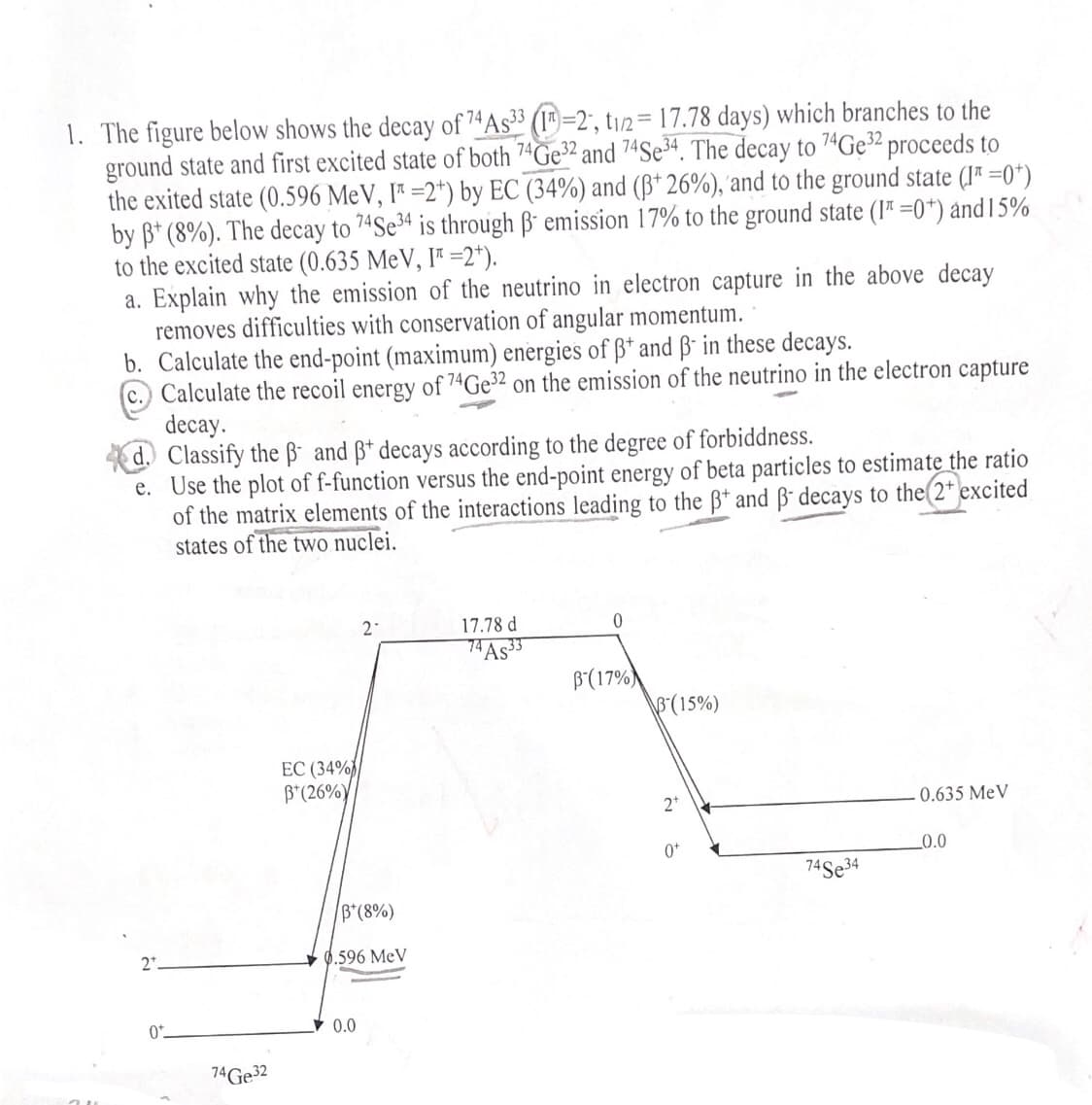1. The figure below shows the decay of 7ªA:³³ (1*)=2', tı2= 17.78 days) which branches to the ground state and first excited state of both 7ªGe³² and 74SE³“. The decay to 74G¢² proceeds to the exited state (0.596 MeV, I* =2*) by EC (34%) and (B* 26%), 'and to the ground state (1* =0*) by ß* (8%). The decay to 74S-³ª is through ß' emission 17% to the ground state (1* =0*) and 15% to the excited state (0.635 MeV, 1* =2*). a. Explain why the emission of the neutrino in electron capture in the above decay removes difficulties with conservation of angular momentum. b. Calculate the end-point (maximum) energies of ß* and ß in these decays. c. Calculate the recoil energy of 74G¢3² on the emission of the neutrino in the electron capture decay. d. Classify the B and ß* decays according to the degree of forbiddness. e. Use the plot of f-function versus the end-point energy of beta particles to estimate the ratio of the matrix elements of the interactions leading to the B* and B- decays to the(2* excited states of the two nuclei.
1. The figure below shows the decay of 7ªA:³³ (1*)=2', tı2= 17.78 days) which branches to the ground state and first excited state of both 7ªGe³² and 74SE³“. The decay to 74G¢² proceeds to the exited state (0.596 MeV, I* =2*) by EC (34%) and (B* 26%), 'and to the ground state (1* =0*) by ß* (8%). The decay to 74S-³ª is through ß' emission 17% to the ground state (1* =0*) and 15% to the excited state (0.635 MeV, 1* =2*). a. Explain why the emission of the neutrino in electron capture in the above decay removes difficulties with conservation of angular momentum. b. Calculate the end-point (maximum) energies of ß* and ß in these decays. c. Calculate the recoil energy of 74G¢3² on the emission of the neutrino in the electron capture decay. d. Classify the B and ß* decays according to the degree of forbiddness. e. Use the plot of f-function versus the end-point energy of beta particles to estimate the ratio of the matrix elements of the interactions leading to the B* and B- decays to the(2* excited states of the two nuclei.
Related questions
Question

Transcribed Image Text:1. The figure below shows the decay of 7ªA:³³ (1*)=2', tı2= 17.78 days) which branches to the
ground state and first excited state of both 7ªGe³² and 74SE³“. The decay to 74G¢² proceeds to
the exited state (0.596 MeV, I* =2*) by EC (34%) and (B* 26%), 'and to the ground state (1* =0*)
by ß* (8%). The decay to 74S-³ª is through ß' emission 17% to the ground state (1* =0*) and 15%
to the excited state (0.635 MeV, 1* =2*).
a. Explain why the emission of the neutrino in electron capture in the above decay
removes difficulties with conservation of angular momentum.
b. Calculate the end-point (maximum) energies of ß* and ß in these decays.
c. Calculate the recoil energy of 74G¢3² on the emission of the neutrino in the electron capture
decay.
d. Classify the B and ß* decays according to the degree of forbiddness.
e. Use the plot of f-function versus the end-point energy of beta particles to estimate the ratio
of the matrix elements of the interactions leading to the B* and B- decays to the(2* excited
states of the two nuclei.
Expert Solution
This question has been solved!
Explore an expertly crafted, step-by-step solution for a thorough understanding of key concepts.
Step by step
Solved in 6 steps with 4 images
